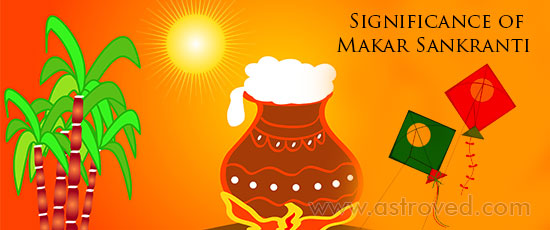Significance of Makar Sankranti
The movement of the Sun from one zodiac to another is called Sankranti and when it moves away from the Tropic of Capricorn and enters the sign Capricorn, the day is celebrated as Makar (Capricorn) Sankranti. This transition of Sun will be celebrated across India with traditional fervor and gaiety on January 15th. Although known by different names, Makar Sankranti is India’s harvest festival.
Auspicious Time for Beginnings and Endings
Sun travels from one sign to another every month but its movement from Sagittarius to Capricorn is considered the most sacred as the transition heralds the revival of warmth, brightness, productivity and prosperity. This movement of Sun is also called ‘Uttarayana’ (Uttar means north and ayana means travel). According to Hindu scriptures, on this day Lord Vishnu annihilated the terror wreaked by demons by severing their heads and burying them under a mountain – symbolizing end of negativities and give way for righteousness and good intensions to live and prosper. It was also the day when king Bhagirath performed tarpanam for his ancestors with the water of holy Ganges after he was able to please Lord Shiva to bring the holy river down on earth. Another well-known reference of this day is - Bhishma Pitamah being wounded by the arrows of Arjuna during the Mahabharata war was lying on the bed of arrows, and waited for Uttarayana to leave his mortal coil. (Bhishma had obtained a boon to choose his time of death) It is believed that death on this day brings salvation to the deceased.
Activities on Makar Sankranti
According to religious scriptures, 40 Ghatis (1 Ghati = 24 minutes) from the time Sun enters Capricorn is considered Punya Kaal Muhurta, auspicious time. The Sun comes close to Shravana star while transiting Capricorn, and that’s when the doors of Lord Vishnu’s abode Vaikunta opens. Shravana star in the sign Capricorn is ruled by Lord Vishnu. People take a dip in holy rivers in the morning and pray to Sun God. They observe fast, pray, spend time with loved ones, honor traditional ritualistic practices, offer donations to the needy etc. If in case the transition of Sun takes place after sunset then Punya Kaal activities are performed the next day. Rituals are performed to pray and worship Sun God for a good harvest and for bestowing abundance and prosperity in the coming days. For Hindus, Sun stands for Pratyaksha-Brahman, a manifestation of the Absolute - bestowing knowledge, spiritual light and wisdom. Sweets made of Sesame (til) seeds and jaggery are essential part of this festival. Some even call the day– Til Sankranti.
Facets of Makar Sankranti
Communities in different parts of India have their own traditional style to commemorate the day. In the states of Bihar and Uttar Pradesh Sankranti is popular as Khichdi whereas down south in Tamil Nadu it is known as Pongal. In both the cases, the name of the festival has come from the traditional dish prepared on the day. In West Bengal, people prepare dishes from rice of the new harvest called Nabanna. People of Gujarat celebrate the day by coloring the sky with beautiful kites, its Uttarayana festival for them. In Assam, elaborate feasts, music, dancing mark the day celebrated as Bhogali Bihu. Called differently, and celebrated differently in different places of India Makar Sankranti is essentially a day to make merry as one soaks oneself in the warmth of nature, togetherness of loved ones and spiritual enlightenment. Children are encouraged to learn from the Sun – shine brightly while illuminating the lives of others with their compassion and knowledge.




















